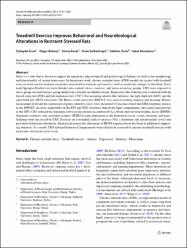Treadmill exercise improves behavioral and neurobiological alterations in restraint-stressed rats
Özet
Stress is a state that is known to impact an organism's physiological and psychological balance as well as the morphology and functionality of certain brain areas. In the present work, chronic restraint stress (CRS) model rats treated with treadmill exercise were used to examine anomalies associated to emotion and mood as well as molecular changes in the brain. Forty male Sprague-Dawley rats were divided into control, stress, exercise, and stress+exercise groups. CRS were exposed to stress group rats and exercise group underwent a chronic treadmill exercise. Depressive-like behavior was evaluated with the forced swim test (FST) and tail suspension test (TST). For assessing anxiety-like behavior, the light-dark test (LDT) and the open field test (OFT) were used. The Morris water maze test (MWMT) was used for testing memory and learning. Brain's monoamine level and the expression of genes related to stress were measured. It was discovered that CRS lengthens latency in the MWMT, increases immobility in the FST and TST, decreases time in the light compartment, and causes hypoactivity in the OFT. CRS reduced the dopamine levels in the nucleus accumbens(NAc). Brain-derived neurotrophic factor (BDNF), dopamine receptors, and serotonin receptor (HTR2A) gene expression in the prefrontal cortex, corpus striatum, and hypothalamus were decreased by CRS. Exercise on a treadmill leads to increase NAc's dopamine and noradrenaline levels and prevented behavioral alterations. Exercise increased the alterations of BDNF expressions in the brain in addition to improving behavior. As a result, CRS-induced behavioral impairments were effectively reversed by chronic treadmill exercise with molecular alterations in the brain.


















